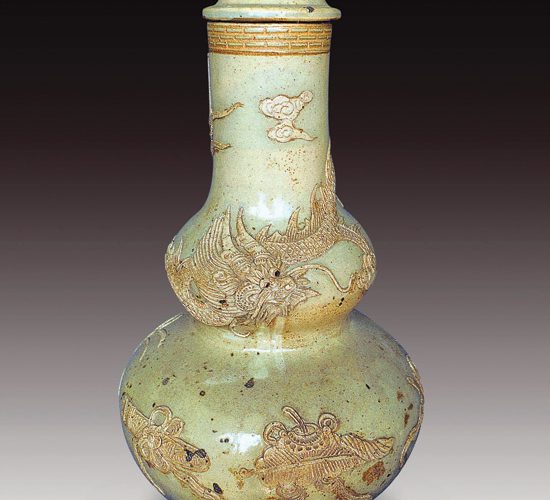(No.8, Vol.3, Sep 2013 Vietnam Heritage Magazine)
Gourd-shaped wine bottle, 19th
century

Lime pots, 18th – 19th
century

Lime pots, 18th – 19th
century

White ceramic vase,
13th – 14th century.
Photos provided by Nguyen Dinh Chien
Vietnam Heritage has been publishing a series based on 2,000 Years of Vietnamese Ceramics by Nguyen Dinh Chien and Pham Quoc Quan, published by Vietnam National Museum of History, Hanoi, 2005.
This month the topic is monochrome crackled and white ceramics.
Vietnamese monochrome white ceramics, which are praised by some Vietnamese antique aficionados as Vietnamese qingbai, are quite different from their counterparts of Five Dynasties (907-960) and Southern Sung (1126-1279). The white glaze is not as thin, transparent and glassy as the Chinese one. Nevertheless, it gives a special impression of deepness.
By the Ly period, white ceramics began to emerge. Earlier, the Five Dynasty greenish white wares poured into Vietnam, especially in Thanh Hoa and Nghe An provinces, becoming prototypes for Vietnamese potters in producing their own.
Ly white ceramics with thick cracked wood-ash glaze include mainly covered jars and tureens (lien) with flat bases or pieced pedestal foots.
Later, Tran white ceramics comprise mostly big vases and ewers with thin greyish white glaze. Some ewers have white and blue glazes. Many ewers have dish mouths, garuda spouts, and handles in haft-circles, and scrimp or fish shapes.
During the Le period, monochrome white ceramics developed in both quantity and quality. The most common types are pots with brown washed bases, jars with short necks, covered tureens, stem-cups and bottle shaped vases (yuhuchun). Many examples have a thin fine glaze on a thin body, and thus just are as translucent as porcelain. Typical are the bowls with the Chinese character for ‘Official’ (ware) found at the sites at Chu Dau (Hai Duong), ancient Hanoi Citadel, Lam Kinh (Thanh Hoa) and Cu Lao Cham shipwreck.
White or greyish-white glaze was used until the eighteenth and nineteenth century for wares produced at Bat Trang (Hanoi), especially, for various cracked white pieces. Typical examples are lime pots, gourd-shaped wine bottles, and lamp-stands and incense burners.
Vietnam National Museum of History
1 Trang Tien St, Hanoi
216 Tran Quang Khai St, Hanoi
Tel: (04) 3824-1384, www.baotanglichsu.vn
Open 8 a.m. to 4.30 p.m.Closed every first Monday of months

